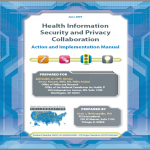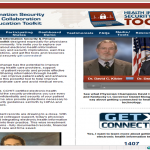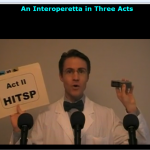Heading and the front page of Action and Implementation Manual link to pdf of the 45-page how-to guide produced from the 7 Collaborations among 42 states and territories referred to in the June 9, 2009 posting below.
http://healthit.hhs.gov/html/hispc/AIMReport.pdf
Monthly Archives: June 2009
Provider Education Toolkit from ONC’s HISPC
Since a picture’s worth a 1,000 words, here’s the home page of the physician toolkit produced by one of the HISPC multi-state Collaborations, referenced in June 9, 2009 post.
http://www.secure4health.org
Health Information Security and Privacy Collaboration (HISPC): States Explain Privacy & Security Agreements
HISPC releases Action and Implementation Manual
Joseph Goedert of HealthData Management reported on June 5, 2009 that “The Health Information Security and Privacy Collaboration (HISPC) has released a how-to guide for state cooperation in health care privacy and security issues.” Referred to as AIM (Action and Implementation Manual), it’s the result of collaborative work between 42 states and territories. According to HISPC site, the ”AIM serves as a how-to guide for each of the seven multistate collaboratives’ tools and templates.”
AIM was prepared for Jodi Daniel, JD, MPH, Director and Steven Posnack, MHS, MS, Policy Analyst of the Office of Policy and Research of the Office of the National Coordinator for Health IT. AIM was prepared by Linda L. Dimitropoulos, PhD of RTI International, Chicago and released in June 2009.
HISPC Site: http://healthit.hhs.gov/HISPC
Action and Implementation Manual 45-page pdf:
http://healthit.hhs.gov/html/hispc/AIMReport.pdf
HISPC Phase 3 Executive Summary (Background on AIM) pdf: http://tinyurl.com/lyrdpb
HISPC June 2009 Seminar Series
“The Seminar Series will be held throughout the month of June on Tuesdays and Thursdays and will include eight 90-minute online seminars. Each seminar will highlight the work and results of the seven HISPC multi-state collaboratives as well as follow-up analysis on state law variation completed by Georgetown University. The HISPC Collaborative presentations will focus on the tools and processes developed and how they can be used by individual, local, regional, and state-level stakeholders.”
http://privacysecurity.rti.org/Default.aspx?tabid=101
HISPC Provider Education Toolkit Video
The HISPC Toolkit for physicians and other healthcare providers ”video {page down on the Press Kit and Tools Web page} was presented at the National HISPC Conference in Bethesda MD in March 2009 and provides a powerful message about electronic health information technology and exchange and the related privacy and security aspects. Please feel free to use this video at any event where health care providers would benefit from awareness of these issues and how to tap in to the Provider Education Toolkit websites and resources.”
http://www.secure4health.org/media.aspx
Health Information Security & Privacy Provider Education Toolkit
http://www.secure4health.org This Web site (including the video featured above) and its resources, built as one of the seven collaborative projects of HISPC, is a treasure and roadmap for educating providers and consumers. “Welcome to the Health Information Security & Privacy Provider Education Toolkit designed especially for physicians and the healthcare community. We invite you to explore our Web site, learn more about electronic health information exchange, related privacy and security implications, earn free CME credits, ask questions, and get the tools and resources you need to safely and securely get connected! ”
http://www.secure4health.org
Thanks to Fred Pennic of Healthcare IT Consultant Blog
Today’s email update from Healthcare IT Consultant Blog, produced by Fred Pennic, and his brief on the HISPC release of AIM, brought the program to my attention and led me down the path of discovery of these resources. Thank you Fred Pennic.
http://hitconsultant.blogspot.com
HISPC National Conference: March 4-6, 2009 Bethesda, MD
Presentations from ”conference showcased the common, replicable solutions developed by seven multi-state collaboratives to the privacy and security challenges presented by the implementation of electronic health information exchange at the state and organizational level.”
HISPC site with relevant working documents: http://privacysecurity.rti.org/
Interoperability Convergence: Physician, Facility, Hospital Alignment
June 10, 2009 Conference on Interoperability Convergence:
Physician, Facility & Hospital Alignment
Presented by NJHIMSS, ACHENJ, MSNJ, ONENJ
Conference Center at NJHA, Princeton, NJ
“Spring Conference where the importance of working together is the focus. Hospitals, physicians and the entire management team need to find solutions to work together not only in the clinical setting, but also through IT…series of interactive presentations and displays by…vendors/sponsors.”
Keynote speaker, Simon Samaha, MD, is president and chief executive officer of Summit Medical Group, appointed in 2009. Among other responsibilities at Cooper University Hospital, where he previously served, Samaha was Chief Information Officer. Samaha earned his MBA at New York University Stern School of Business, his MS in Information Systems at Drexel University, and his MD at Saint Joseph University in Lebanon. Samaha was named in Modern Healthcare’s 2001 list of Up and Comers and is board-certified in internal medicine
Register online via credit card, or make checks payable to NJHIMSS.
http://njhimss.org/downloadlibrary/downloadlibrary.html
HITECH: An Interoperetta in Three Acts
Four minutes of HIT Fun
Produced and performed by Ross Martin, MD, one brief session introduces and harmonizes key elements of what’s happening in Health IT world. http://www.rossmartinmd.com/blog.htm
Dr. Martin is a serious health informatics guy with clinical, pharmaceutical, and consulting experience. And then there’s Ross’s other side, which we could all benefit from as well. So listen up to the very end, including the credits, not to miss any of the fun. While this is a serious blog, it seemed some good fun was in order.
ONC Proposes Regional IT Extension Centers
US Seeks Input for Establishing Regional IT Extension Centers
Reported by Helen Pfister of Manatt Health Solutions for California HealthLine. “In addition to well-publicized incentives to get doctors to start using electronic health records, the federal stimulus package also dangles financial carrots to encourage the establishment of what will amount to a new mini-industry involved with helping those doctors choose and use EHRs.
“Applicants identifying viable sources of matching funds, including but not limited to grants from states and not-for-profit foundations, and payment for services from providers. “
ONC Proposes Health Information Technology Regional Extension Centers
Healthcare Technology News reports on Regional Extension Centers
HTN reported on June 2, 2009 that the ONC has proposed Health Information Technology Regional Extension Centers to help providers achieve meaningful use. Funding between $1 and $10 million. Comments due back by June 11, 2009.
Based on Federal Register May 28, 2009 notice:
http://edocket.access.gpo.gov/2009/E9-12419.htm
Office of the National Coordinator for Health Information Technology (ONC), HHS;
Notice of Availability: Secretarial Recognition of Certain Healthcare
Information Technology Standard Panel (HITSP) Interoperability
Specifications and the Standards They Contain as Interoperability Standards for Health Information Technology
Excerpt: “We propose that the goals of the regional center program should be to:
–Encourage adoption of electronic health records by clinicians and
hospitals;
–Assist clinicians and hospitals to become meaningful users of
electronic health records; and
–Increase the probability that adopters of electronic health record
systems will become meaningful users of the technology.”
http://edocket.access.gpo.gov/2009/E9-12419.htm
organizational plans and implementation strategies incorporating multi-
stakeholder collaborations that leverage local resources. The local
stakeholders and resources that applicants may wish to consider
including in some combination, though not limited to, the following:
Public and/or private universities with health professions,
informatics, and allied health programs; state or regional medical/
professional societies and other provider organizations; federally
recognized state primary care associations; state or regional hospital
organizations; large health centers and networks of rural and/or
community health centers; other relevant health professional
organizations; the regionally relevant state Area Health Education
Center(s); health information exchange organizations serving providers
in the region; the Medicare Quality Improvement Organization(s)(QIO(s) serving
providers that the proposed regional center aims to serve; state and
tribal government entities in the center’s geographic service area
including, but not limited to, public health agencies; libraries and
information centers with health professional and community outreach
programs; and consumer/patient organizations.”
“As noted below, we propose to give preference to
applicants identifying viable sources of matching funds. Viable sources
could include grants from states, non-profit foundations, and payment
for services from providers able to make such payment. For example,
Medicaid providers could choose to contract with a regional center in
lieu of a corporate vendor for implementation and meaningful use
support services, for which costs are reimbursable under Section 1903
of the Social Security Act, as amended by the HITECH Act. A regional
center could also, theoretically, seek to establish itself as a first-
choice source of assistance that would realize net retained earnings on
service to non-prioritized providers and use those retained earnings as
a source of matching funds for its grant-funded activities.
Concise Guide to CCHIT Criteria
CCHIT Releases EHR Criteria for Ambulatory, Inpatient, Enterprise and ED
Guide to CCHIT Criteria covers the Ambulatory (office-based) and Inpatient (hospital-based) criteria specifically.
Press release (pdf)
Concise Guide to CCHIT Criteria (pdf)



